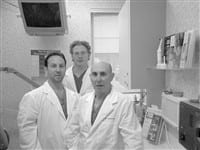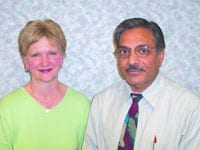Not Just ‘Drill And Fill’ Springfield Dental Practice Boasts Array Of Technologies, Procedures
In the classic Christmas TV special, Rudolph the Red-nosed Reindeer, Rudolph’s little elf friend, Herbie, is a misfit because he wants to be a dentist. In the 1960s, when the program was produced, maybe that meant something. Dentistry had a reputation of being a painful “drill-and-fill” occupation.
But not anymore. In fact, according to Dr. Gary Goodman, dentistry is an exciting occupation to be in today.
“It’s a much more inclusive field now,” Goodman said. “There are so many different facets to dentistry today. It’s pretty exciting.”
Long gone, too, are the days of painful, traumatic drilling. The use of local anesthetics has long since put that old cliché to rest. Furthermore, new techniques like lasers and air abrasion have reduced patient discomfort. Never before has dentistry been so non-traumatic.
Something to Chew On
“People are making a better effort to take care of their teeth,” Goodman told The Healthcare News. The reasons, he notes, are varied, but one stands out. The correlation between dental health and general health is becoming better understood, not only by dentists and physicians, but by the general public.
“For instance,” he said, “there is a clear connection between gum disease and heart disease. The bacteria that cause gum disease can cause heart problems. It affects the whole body. Another example is that people with diabetes are more prone to gum infection.”
As a result, in such cases, it’s often a dentist who sees the symptoms first. That’s one of the aspects of modern dentistry that has Goodman so excited. “Dentists work more closely now with physicians than ever before,” he said. “After all, dentistry is a type of medicine; it’s just dedicated to the mouth. It overlaps more and more with general medicine.”
All of the dentists at Goodman’s Springfield practice are laser-certified, although he is not quite ready to embrace lasers completely just yet. “It is clearly the wave of the future,” he said, “but it still has drawbacks, particularly when used on hard tissue such as teeth. We use lasers mostly for soft tissue like gums now, but that will all change in the future as this technology, like all technology, becomes more sophisticated.”
Another aspect of modern dentistry that Goodman finds exciting is the area of cosmetic dentistry.
“Cosmetics is the big thing today,” he told The Healthcare News. “Ten years ago, we had to educate people about what was available. Now, they come to us and ask for certain procedures. People have become so much more aware of the idea of makeovers today. It’s really growing very fast. It’s been sensationalized on TV. People see the results, and they say, ‘wow! That would look great! It would be worthwhile for me, too.’”
Growing, too, are the number of ways that dentists can approach a patient’s needs. “Dentists have a lot of answers to problems, where, in the past, we didn’t have as many options,” he said.
One of the most popular procedures is veneers, essentially coverings for the front of the teeth that can result in an evenly matched set of bright, white teeth — in other words, the perfect smile. In one sense, they are similar to the plastic overlays that women sometimes use on their fingernails.
However, because they are not merely cosmetic and must still perform an important function — biting and chewing food — they must be able to stand up to far stronger forces than fingernails do. “The veneer is actually rather fragile until it is bonded in place,” Goodman explained. “Once it is bonded on, though, it’s incredibly strong.”
The entire process takes about two weeks from the initial prep work on the teeth to final bonding of the veneer into place. Much of that time is taken by the lab that actually creates the veneer to the dentist’s specifications. The material itself is a type of porcelain.
One reason why cosmetic dentistry is so popular is that its cost is relatively low, especially compared to such things as cosmetic surgery. Because they are elective procedures, cosmetic dental work is only rarely covered by insurance. A single veneer, though, costs as little as $750.
“Usually, you only do a couple of teeth that way,” Goodman said. “There’s no need to veneer teeth in the back of your mouth since you can’t see them anyway.” As a result, more people can afford to pay for a nice-looking smile rather than, say, a facelift. Goodman says the most veneers he has ever placed on one patient is eight, and he noted that it’s rare to attach that many at once.
Even in the area of old-fashioned fillings, cosmetic concerns have resulted in a wide variety of new materials in recent years. Goodman notes that these materials not only give dentists more choices, but are also continually improving.
“For instance, he said, “we use white fillings now much more than the silver amalgam of years ago. It looks nicer, and the materials are much stronger now than when they first came on the market.”
Open Wide
If Goodman has seen many changes in his profession during his years as a dentist, his father, Richard, has seen even more. It was the elder Goodman who began the practice on Bridge Street in Springfield in 1962. Gary joined in 1986, and about four years ago, Dr. Aaron Fox came on board.
The Goodmans spent some 25 years on Maple Street before moving to their current location in the medical building at 3455 Main St. Currently, they have some 9,000 active patients.
“We even have some who come down from Vermont,” Gary Goodman said with a smile, explaining that they are longtime patients of his father’s who prefer to travel rather than transfer to a local dental practice.
The practice is simply called Goodman, Goodman, and Fox. There’s a very good reason for that rather than using a more general name like “Springfield Dental Associates” or something similar, Goodman said.
“We’re a family practice. People know us by name. We didn’t want to lose that even if we are growing in size. It’s important to us to maintain that individual doctor/patient relationship.”
Indeed, the practice still maintains Saturday hours once a month and evening hours Mondays and Tuesdays. The younger Goodman now serves as vice president and managing partner since his father is now semi-retired and comes in for only two and a half days a week. He says that the practice would like to expand further, but “our biggest problem right now is space. We’d like to bring in another dentist.”
Currently, the office also has four hygienists, one of whom is part-time, and five members on its clerical staff with another four assistants. It’s easy to see why the offices which seemed so spacious 10 years ago seem a little more cramped nowadays.
As a general dental practice with six work stations, Goodman and Fox perform almost all dental procedures themselves, from surgery to pediatric dentistry. They do refer out to specialists under unique circumstances, particularly for orthodontic work.
“Whenever there’s a question, we refer out, and we don’t do a lot of orthodontic work here,” Goodman said. “We do whatever is best for the patient.”
And today, that “whatever” covers a lot of ground.



Comments are closed.